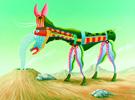Introduction to Li Songshan and Han Rong
The couple, Li Songshan and Han Rong, began to learn Swahili in the 1960s. (Swahili, belonging to the Bantu language family, is spoken by about 100 million people in Africa. It is the national language of Tanzania and Kenya, and is also commonly used in such East African countries as Somali, Uganda, Malawi, Burundi, Rwanda, Mozambique and the Congo).
Over the past years, the couple has been actively engaged in Sino-Tanzanian cultural and economic exchange, dedicating the prime of their youth and enormous efforts to promoting international friendship and the development of Sino-African relations.
Since1960s and 1670s, they began to engage in translation work and participated in the translation of Selected Works of Mao Zedong and a great volume of documents, novels and literary works. They have also participated in the compilation of Swahili-Chinese dictionaries.
Between the late 1970s and the 1980s, the couple, dispatched by the Chinese Government, first served as interpreters for China’s foreign-aid expert groups and medical teams, and later worked for a cultural institution of China stationed in Tanzania.
In 1990, the couple resigned public employment and made emigration to Tanzania, starting a new career on this foreign land, which is fraught with hardships and challenges.
After experiencing numerous twists and turns over the past 16 years, Li and Han have become eminent Chinese entrepreneurs in Tanzania, and won the fame for their in-depth study and rich collection of African artworks. They have collected more than 10,000 masterpieces of Makonda woodcarvings and established a private Makonda art museum in Tanzania. They also have initiated and organized the Tanzania National Makonda Art Association, with the participation of many
local artists, and Li serving as its president and Han its secretary-general.
In May 1997, at the invitation of the Chinese Ministry of Culture and representing the Tanzanian Government, the couple held a grand exhibition of Tanzanian arts and crafts at the Beijing Working People’s Cultural Palace. After that, they sponsored and participated in a number of other international exhibitions.
In June 2003, the couple contributed to the People’s Government of Changchun more than 500 exquisite African modern woodcarvings, which are now collected and exhibited by the Changchun Sculpture Art Museum. The People’s Government of Changchun granted the couple the title as lifetime honorable curators of the museum. Former president of Tanzania sent a message of greetings, speaking highly of the couple’s lifetime devotion to the study and collection of Makonda artworks and their great contribution
to the development of human culture and art. In September the same year, the couple attended the World Sculpture Meet in Changchun at invitation, at which they delivered a paper entitled “A Brief Talk on Makonda Sculpture Art--the Spirit of Black Africa”.
In December 2004, the couple presented 157 pieces of African modern woodcarvings to the China Art Gallery, adding an array of African art treasures to it.
In May 2005, the couple opened the Africa Impression salon at the compound of Beijing Impression in the western suburbs of Beijing, hoping to show off the marvelous art and folklore of Africa and set up a platform for Chinese artists and scholars who yearn to approach African culture and arts.
Words from Collectors
—— An insoluble bond with the Black Spirit
An experience fraught with hardships,
A peculiar yet enjoyable tough cultural journey,
Several dozen years of persistent searching and study,
Only yearn for approaching its origin, stroking its texture, sensing its innate mystery, and appreciating its unique charm.
--It’s a treasure-house of human civilization.
We ardently hope the coming of a batch of young people who will, as we did in our youth, bravely take this tough but happy journey, which, surely, will add great brilliance to humanity.










